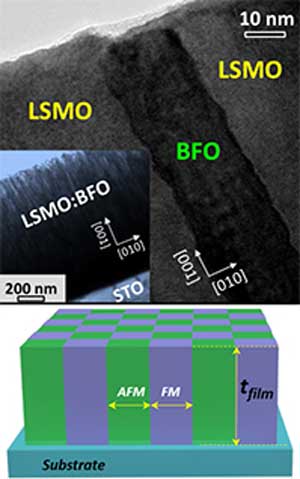| Posted: Jan 09, 2017 |
Lining up for new high-density memory devices
(Nanowerk News) To reduce the size and increase the durability of computers, cell phones, and other data-storing devices, scientists designed a structure made of tiny layers, which resembles a thick chessboard butcher-block table (Nanoscale, "Strong perpendicular exchange bias in epitaxial La0.7Sr0.3MnO3:BiFeO3 nanocomposite films through vertical interfacial coupling").
|
 |
| (Top) Cross-sectional transmission electron microscopy (TEM) image of vertically aligned La0.7Sr0.3MnO3 (LSMO) film showing a BiFeO3 (BFO) pillar embedded in the LSMO matrix. These structures were grown lattice matched onto a SrTiO3 (STO) substrate. The inset shows a low magnification cross-sectional TEM image, illustrating the alternating growth of LSMO and BFO vertical pillars. (Bottom) Schematic illustration of the antiferromagnetic (AFM) and ferromagnetic (FM) layers in the vertically aligned nanocomposite film. In the figure, t = thickness. (Image: Department of Materials Science & Engineering, Texas A&M University)
|
|
Using the material, where each layer is made of one of two composites, scientists can vertically manipulate the magnetization, enabling a type of magnetic coupling between two layers commonly employed in magnetic devices. They can “pin,” or set, the magnetic states of the materials at their unique states of maximum sensitivity; this setting is essential for magnetic device stability.
|
|
Extremely thin layers of a unique material could lead to the design of new read heads for hard drives and other high-density memory devices that have greater stability when exposed to high temperatures and a smaller size.
|
|
Scientists grew a vertically aligned nanocomposites lattice matched on a SrTiO3 (STO) substrate using laser deposition. These micrometer-thick layers exhibited strong, perpendicular (vertical) magnetic coupling (exchange bias).
|
|
The degree of structural strain in the nanocomposites effects the magnetic exchange bias behavior (that is, a type of magnetic coupling between two layers commonly employed in magnetic devices).
|
|
In addition, the composition of the different layers in the film (La0.7Sr0.3MnO3 [LSMO] and BiFeO3 [BFO]) determines the density, degree of strain accommodation, and magnetic phase transition, which all affect the overall magnetic exchange bias coupling strength.
|
|
By controlling the composition of the layers in the nanocomposites, scientists can tune the degree of magnetic exchange bias coupling strength. The research team conducted a microstructural analysis of the nanocomposite films using transmission electron microscopy and scanning transmission electron microscopy. The images show vertical structures with boundaries. They measured the magnetization of the nanocomposites using a magnetometer.
|
|
This new nanoscale architecture can be used for data storage in high-density memory devices as an alternative to conventional, in-plane magnetic exchange bias; such devices could provide more efficient performance.
|

